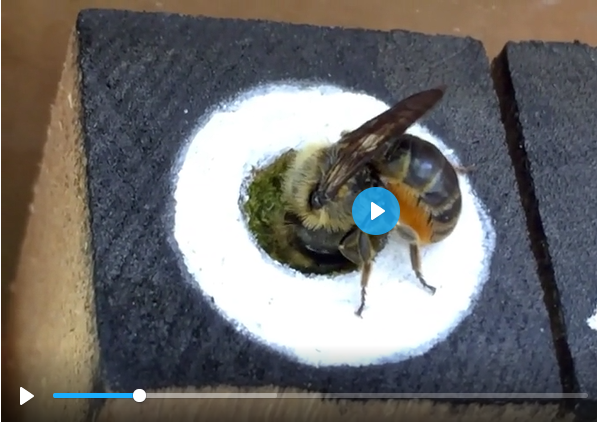Some bees are born curious while others are more single-minded by Chelsea Cook, The Conversation Researchers marked the bees visiting this feeder with yellow. Credit: Chelsea Cook, CC BY-SA When you try to pick a restaurant with a group of friends, how do you decide? Your curious friend wants to try the new place, while your focused […]
Category: Behaviour
Study finds native bees turning to polystyrene for nesting places by Lucien Wilkinson, Curtin University
Study finds native bees turning to polystyrene for nesting places by Lucien Wilkinson, Curtin University Credit: CC0 Public Domain New Curtin University research has found that polystyrene can serve as a nesting place for native bees, which are able to exploit the man-made material for their own benefit. The study, published today in peer-reviewed journal Apidologie, […]
Researchers must ‘bee’ sweep netting to learn more about native bees
Researchers must ‘bee’ sweep netting to learn more about native bees by Curtin University An Amegilla bee. Credit: Kit Prendergast, Curtin University Novel research into native bee populations by Curtin University provides a best practice recommendation on how to accurately monitor these important insects, with the aim of monitoring and saving bee species from emerging environmental […]
Recycling old genes to get new traits: How social behavior evolves in bees
Recycling old genes to get new traits: How social behavior evolves in bees by Smithsonian Tropical Research Institute Bees (Megalopta genalis) become queens by subjugating their daughters, who go out to forage for food, while the queen stays at home. Credit: Callum Kingwell A team working at the Smithsonian Tropical Research Institute (STRI) found evidence to […]
Early arrival of spring disrupts the mutualism between plants and pollinators by Hokkaido University
JULY 12, 2019 Early arrival of spring disrupts the mutualism between plants and pollinators by Hokkaido University A bumblebee visits Corydalis ambigua after overwintering. Photo taken by Yuimi Hirabayashi. Credit: Bihoro Museum Early snowmelt increases the risk of phenological mismatch, in which the flowering of periodic plants and pollinators fall out of sync, compromising seed production. […]
Out of sync: Ecologists report climate change affecting bee, plant life cycles by Mary-Ann Muffoletto, Utah State University
AUGUST 19, 2020 Out of sync: Ecologists report climate change affecting bee, plant life cycles by Mary-Ann Muffoletto, Utah State University Andrena transnigra (black-banded miner bee) on Solidago multiradiata (Rocky Mountain goldenrod) at the Rocky Mountain Biological Laboratory near Gothic, Colorado. Utah State University and North Carolina State University ecologists, along with a multi-institution team, report […]
ARS,, Helping Honey Bees make it through Winter with early cold storage
Helping Honey Bees Make It Through Winter With Early Cold Storage; New Website Available 06/22/2020 View as a webpage ARS News Service Helping Honey Bees Make It Through Winter With Early Cold Storage; New Website Available For media inquiries contact: Kim Kaplan, 301-504-1637 June 22, 2020 TUCSON, ARIZONA, June 22, 2020—Putting honey bees into […]
Diet quantity influences caste determination in Honey Bees (Apis mellifera)
Research articles Diet quantity influences caste determination in honeybees (Apis mellifera) Garett P. Slater , George D. Yocum and Julia H. Bowsher Published:27 May 2020https://doi.org/10.1098/rspb.2020.0614 Review history Abstract In species that care for their young, provisioning has profound effects on offspring fitness. Provisioning is important in honeybees because nutritional cues determine whether a female becomes […]
Vomiting bumblebees show that sweeter is not necessarily better

Animal pollinators support the production of three-quarters of the world’s food crops, and many flowers produce nectar to reward the pollinators. A new study using bumblebees has found that the sweetest nectar is not necessarily the best: too much sugar slows down the bees. The results will inform breeding efforts to make crops more attractive […]
Smart single mother bees learn from their neighbours

Solitary female bees inspect other nests for signs of danger before making decisions on where to build their own, a new London-based study suggests. The study, led by researchers at Queen Mary University of London, found the clever bees looked for signs of parasite infection in other species‘ nests and used this information to select a […]